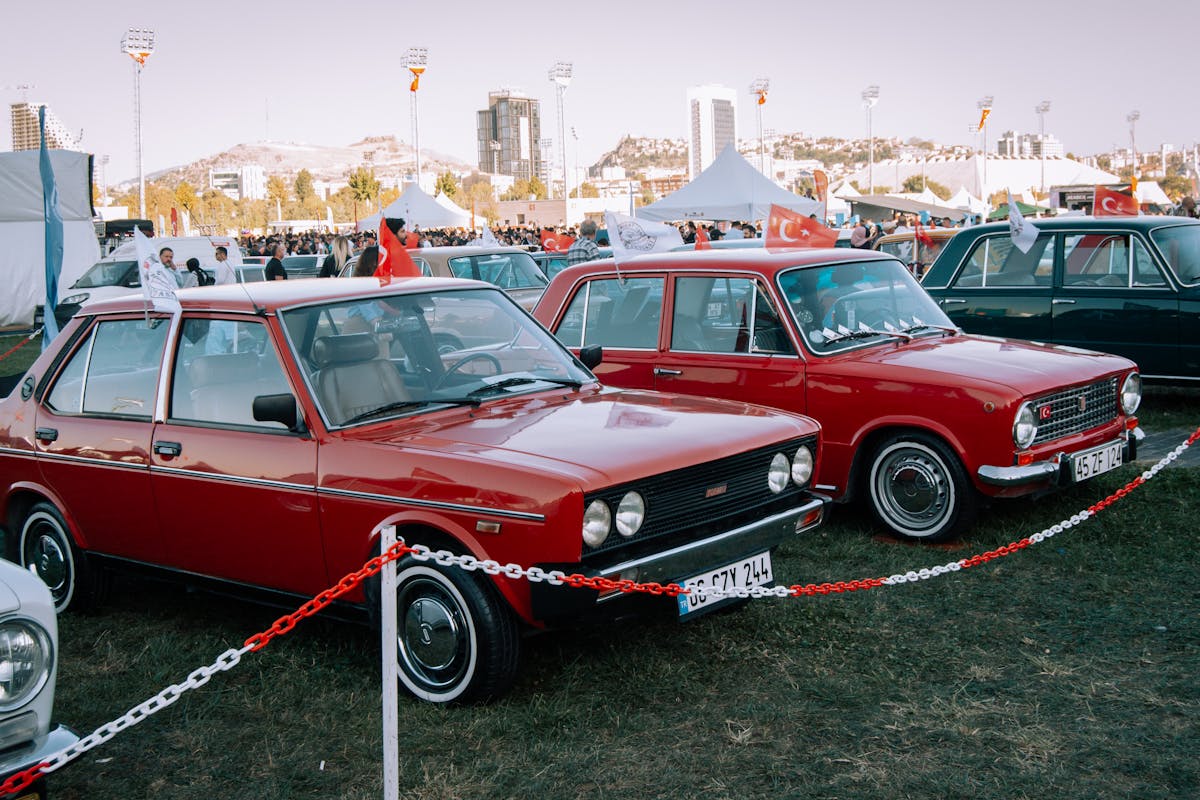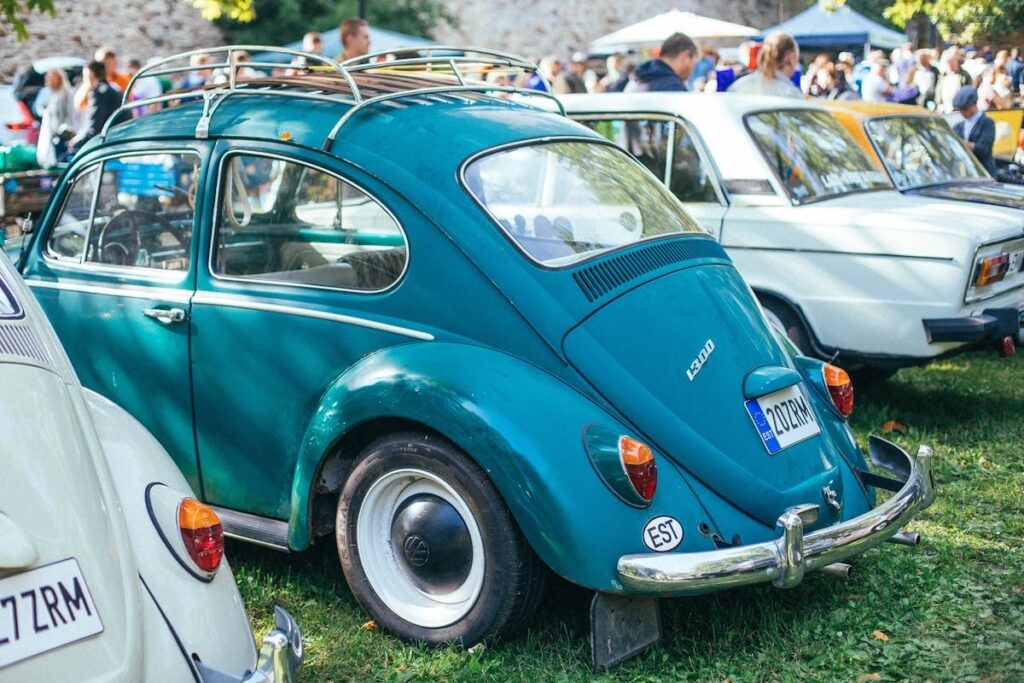Classic car meetups are an intriguing facet of local communities, offering a unique blend of social interaction, historical preservation, and mechanical artistry. These gatherings, typically showcasing a variety of timeless automotive marvels, serve as a platform for enthusiasts to share their passion, knowledge, and stories. As these events are also known to provide access to valuable resources and connections for restoration and maintenance, one might wonder about the potential benefits that await an aspiring classic car enthusiast.
Key Takeaways
- Local car clubs often organize classic car meetups, offering networking and knowledge-sharing opportunities.
- Newspapers, magazines, and online platforms dedicated to classic cars list upcoming local events.
- Active participation in local meetups enhances understanding and appreciation of vintage vehicles.
- Social media groups focused on classic cars can provide information on local events and meetups.
- Attending local meetups allows enthusiasts to inspect classic cars for potential buying or selling, fostering industry connections.
Understanding Classic Car Meetups
Drenched in nostalgia, classic car meetups present an exciting opportunity for automobile enthusiasts to come together and appreciate the beauty of vintage automobiles. These events, often held in communal spaces like parks or car parks, are a vibrant reflection of the classic car culture that thrives in various communities across the globe.
Classic car meetups are much more than mere gatherings; they are an integral part of the preservation and propagation of vintage vehicle culture. These events provide a platform for enthusiasts to exchange knowledge about restoration techniques, parts sourcing, and historical contexts of different models. The shared passion for vintage vehicles not only strengthens community bonds but also fuels the ongoing efforts towards vintage vehicle preservation.
A detailed analysis of these meetups reveals an interesting mix of participants, ranging from seasoned collectors to curious spectators. The former often showcase their restored beauties, while the latter soak in the allure of these timeless machines. These events also attract professional restorers, historians, and photographers, further enriching the cultural milieu.
Benefits of Attending Meetups
Immersing oneself in the vibrant atmosphere of classic car meetups offers manifold benefits, extending far beyond the domain of automobile appreciation. One of the primary advantages is community bonding. These gatherings serve as a common place for classic car enthusiasts, providing a platform for individuals with shared interests to connect. This camaraderie often leads to lasting friendships, enriched by a mutual passion for vintage vehicles.
Knowledge sharing is another significant benefit. Meetups provide a unique environment where participants can exchange information, tips, and tricks about car restoration, maintenance, or history. This mutual learning process enhances enthusiasts’ understanding and appreciation of classic cars. Additionally, experienced members often mentor newcomers, fostering an atmosphere of inclusivity and mutual respect.
Furthermore, attending these meetups can be advantageous for those interested in buying or selling classic cars. They provide an opportunity to inspect a variety of vehicles firsthand, consult with knowledgeable enthusiasts, and establish valuable connections within the industry.
Preparing for Your First Meetup
Having explored the benefits, let’s shift our focus towards the practical steps you can take when preparing for your first classic car meetup. First, car maintenance is essential. Make sure that your classic vehicle is in excellent condition. This involves checking all fluid levels, inspecting the brakes, tires, and lights, and making certain the engine is running smoothly. A well-maintained car not only reduces the risk of breakdowns but also presents a good impression to fellow enthusiasts.
Secondly, vehicle insurance is an indispensable aspect of preparation. Even if it’s not mandatory in your region, it’s recommended to have an appropriate coverage plan for your classic car. Insurance protects you financially from unexpected incidents such as accidents or damages that may occur during the meetup. Remember, classic cars are valuable assets and their parts can be costly to replace.
Lastly, familiarize yourself with the location of the meetup and the expected etiquette. Arriving on time, respecting the venue, and adhering to any specific rules laid down by the organizers will guarantee a pleasant experience for all. If it’s an outdoor event, consider the weather forecast and make necessary preparations. With these steps, you should be well-prepared for your first classic car meetup.
Identifying Popular Classic Car Models
At classic car meetups, it is essential to be able to identify popular car models in order to fully appreciate the event. This involves recognizing iconic car designs and understanding the variety of models that are typically showcased. In addition, knowledge of a model’s history adds depth to one’s understanding, enriching the overall experience.
Recognizing Iconic Car Designs
The allure of classic cars often lies in their distinctive and iconic designs. These designs, crafted by skilled engineers and designers, encapsulate the spirit of the time in which they were conceived. They serve as a tangible representation of the design evolution that has occurred over the decades, with styles ranging from the streamlined bodies of the 1930s to the sharp angles and boxy shapes of the 1980s.
Iconic features, such as the Chevrolet Bel Air’s tail fins, or the Volkswagen Beetle’s round silhouette, are easily recognizable and cherished by enthusiasts. Meanwhile, the Ford Mustang’s long hood and short rear deck became a blueprint for muscle cars. The Jaguar E-Type’s sleek and aerodynamic shape, favored by many as the most beautiful car ever made, exemplifies the forward-thinking design of the 1960s.
Recognizing these design elements is integral to appreciating the artistry of classic car design. Just as one would study brush strokes in a painting, understanding these details can provide insight into the era, the designer’s vision, and the technological advancements of the time. Ultimately, the design is a critical aspect of what makes a classic car truly iconic.
Classic Car Model Varieties
Enthusiasts’ appreciation for classic cars doesn’t stop at their iconic designs; it extends to the varying models and their unique attributes. The diversity in model varieties is as broad as the timeline of automotive history itself, offering a rich palette for vintage restorations.
Popular classic car models span several decades and encompass a range of styles. From the elegant curves of the 1957 Chevrolet Bel Air to the muscle-bound profile of the 1969 Ford Mustang, each model is a snapshot in time, embodying the aesthetic and technological trends of its era. Model comparisons often focus on these distinctive qualities, highlighting the differences in design philosophy and mechanical engineering between manufacturers and periods.
The 1963 Corvette Stingray, for instance, is renowned for its split rear window, a feature unique to that model year. In contrast, the 1970 Dodge Challenger is celebrated for its powerful engine options and aggressive styling.
In the sphere of classic European cars, models like the 1961 Jaguar E-Type and the 1955 Mercedes-Benz 300SL Gullwing stand out for their innovative design and engineering feats. Each of these models, restored to their original glory, represents a different facet of the classic car enthusiast’s passion.
Importance of Model History
Understanding the history of a classic car model is an integral part of the enthusiast’s journey, as it provides context to the evolution of design, technology, and philosophy behind each car. The heritage appreciation of these automobiles is not just a nod to nostalgia, but an acknowledgment of the technical advancements that laid the groundwork for contemporary vehicles.
One cannot fully appreciate the craftsmanship of a 1960s Ford Mustang, for instance, without understanding the model evolution that led to its creation. The Mustang’s compact, stylish design was a revolution in the auto industry, breaking away from the larger, more traditional cars of the 1950s. Its success prompted competitors to develop similar models, influencing the direction of automotive design for decades to come.
Moreover, the model history also reveals societal trends and cultural shifts of the era, adding another layer of richness to the narrative. Consequently, any classic car meetup is incomplete without an informed discussion about model history. It adds depth to the conversation, fosters a deeper understanding, and enhances the overall experience of owning, restoring, and showcasing these vintage beauties.
Networking Tips for Car Enthusiasts
While it may seem intimidating for newbies, establishing meaningful connections within the classic car community can be an enriching experience. The car culture is characterized by shared interests, where networking strategies are essential to tap into enthusiast communities. Successful networking can lead to relationship building, fostering social connections that transcend the love for classic cars.
Event participation is a key element in these networking strategies. Attending car shows, auctions, and local meetups provide opportunities to interact with like-minded individuals. These events serve as a platform for hobby collaboration, where enthusiasts can share insights, tips, and personal experiences. Regular involvement in these events can help solidify your place within the community, highlighting your commitment to the classic car culture.
Resource sharing is another significant aspect of networking. Sharing information about restoration techniques, coveted car parts, or trusted mechanics can help strengthen bonds within the community. This exchange not only enriches your knowledge but also contributes to the collective wisdom of the group. Ultimately, networking within the classic car enthusiast communities is about fostering a sense of camaraderie, sharing a mutual passion, and working together to preserve the rich history of classic automobiles.

Finding Local Classic Car Events
To explore the heart of classic car culture, discovering local classic car events is an essential step. These gatherings provide a platform to appreciate the aesthetic and engineering marvels of yesteryears, exchange knowledge with fellow enthusiasts, and foster a sense of community.
Finding these events can seem intimidating, but by leveraging local resources, the task becomes considerably simpler. Local car clubs often organize events and meetups; becoming a member not only gives access to exclusive events but also to a network of like-minded individuals who can share information about other gatherings.
Another valuable resource is local newspapers and magazines. They often feature event calendars that list upcoming car shows and meetups. Online platforms should not be overlooked either. Websites dedicated to classic cars often host event calendars that list gatherings on a national and local level. Social media platforms, particularly those with a focus on community groups, can also prove beneficial.
Participating in Classic Car Competitions
Engaging in classic car competitions requires a unique approach and specific preparation. This includes readying your vintage vehicle for the contest, understanding and adhering to competition etiquette, and developing winning strategies. This segment aims to provide valuable insights and practical tips to help you stand out in the field and potentially secure a victory.
Preparing Your Vintage Vehicle
The exhilaration of a classic car competition begins long before the rubber meets the road. It starts with meticulous preparation of your vintage vehicle, applying a combination of vehicle maintenance tips and restoration techniques to guarantee your classic car is ready for the spotlight.
Vehicle maintenance is vital for any car, but even more so for vintage ones. Regular oil changes, tire inspections, and brake checks are essential. Overlooked aspects like checking the seals for leaks, testing the battery, and verifying the cooling system is functioning efficiently can make the difference between a successful ride or a breakdown.
Restoration techniques, on the other hand, focus on bringing your classic car back to its original glory. This process involves careful assessment and potential overhaul of the car’s bodywork, interior, and mechanical components. Professional restorers often use methods like sandblasting to remove rust and old paint, repairing or replacing damaged parts, and using high-quality paints to replicate the car’s original finish.
Navigating Competition Etiquette
Once your treasured classic automobile has been meticulously restored and prepared for the event, understanding and adhering to the etiquette of classic car competitions is a worthwhile next step. This not only involves knowing the rules but also fostering an atmosphere of competition respect and friendly rivalry.
To navigate this social terrain, first and foremost, remember that classic car competitions aren’t solely about winning. They serve as a platform to admire and appreciate the beauty and history of classic cars. Hence, it’s essential to respect your rivals’ cars as much as your own. Commenting generously on their vehicles, sharing restoration stories, and offering constructive criticism can build a positive rapport.
Secondly, friendly rivalry should be the backbone of competition etiquette. While competition can be intense, maintaining a jovial atmosphere can make the event more enjoyable for everyone involved. Teasing and light-hearted banter can be part of the experience, but remember to keep it positive and respectful.
Lastly, in the spirit of competition respect, it’s imperative to acknowledge the effort and passion of other participants. Whether they have a pristine classic or a work-in-progress, everyone’s contribution to the event deserves recognition.
Winning Strategy Tips
Success in classic car competitions requires more than just a beautifully restored automobile. The winning strategy lies in a deep understanding of the car restoration process, knowledge about vintage modifications, and a keen eye for detail.
A successful car restoration involves meticulous planning and execution. Each component of the vehicle, from the engine to the upholstery, needs to be restored or replaced with an equivalent that maintains the car’s original essence. Judges in these competitions often favor authenticity, so using appropriate materials and techniques is key.
Vintage modifications, however, are a different ball game. While maintaining the classic essence of the car, these modifications should also enhance its functionality or appearance. For instance, installing a vintage-looking radio that incorporates modern technology can be a winning modification. But remember, it’s a delicate balancing act between improving the car and preserving its vintage charm.
Frequently Asked Questions
What Insurance Considerations Are There for Classic Cars?
Classic car insurance considerations involve appraising the vehicle’s value accurately, understanding policy conditions, and evaluating coverage options. Vintage vehicle policies often require specific conditions met for maximum protection, including storage and usage stipulations.
How Can I Start My Own Local Classic Car Meetup?
To initiate your own gathering, consider proper venue selection that accommodates the vehicles’ size and quantity. Implement promotional strategies such as social media, local advertisements, and word-of-mouth to attract likeminded enthusiasts and guarantee the event’s success.
What Maintenance Tips Are There for Classic Car Owners?
Classic car maintenance involves meticulous engine care and tire maintenance. Regular oil changes, engine tune-ups, tire rotation and alignment checks are vital. Additionally, preserving the car’s originality is essential for maintaining its value and appeal.
Are There Specific Driving Laws for Classic Cars?
Classic cars may be subject to specific driving laws, depending on the nature of modifications and local vintage vehicle regulations. It is crucial to verify these laws to confirm the legality of your classic car’s operation.
Can Children Attend Classic Car Meetups?
Yes, children can attend classic car meetups. These events often include family-friendly activities. However, kids’ safety is paramount; organizers typically put measures in place to guarantee a secure environment for all attendees, including younger participants.

